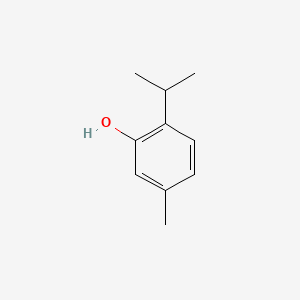Thymol
Thymol is a lipid of Prenol Lipids (PR) class. Thymol is associated with abnormalities such as Anemia, end organ damage, Dental caries, CLEFT LIP, CONGENITAL HEALED and Wiskott-Aldrich Syndrome. The involved functions are known as synergism, antagonists, Metabolic Inhibition, Pressure- physical agent and Drug Interactions. Thymol often locates in Mucous Membrane, apical membrane, Protoplasm, Extracellular and Serosal. The associated genes with Thymol are HIST1H1C gene, TRPA1 gene, MERTK wt Allele, SLC12A2 gene and TRPV3 gene. The related lipids are Propionate, Pinene, palmitoleic acid, pentadecanoic acid and stearic acid.
References related to locations published in Others
| PMID | Journal | Published Date | Author | Title |
|---|---|---|---|---|
| 10460231 | J. Neurosci. | 1999 | Krizaj D et al. | Caffeine-sensitive calcium stores regulate synaptic transmission from retinal rod photoreceptors. |
| 18703525 | J. Antimicrob. Chemother. | 2008 | Karpanen TJ et al. | Antimicrobial efficacy of chlorhexidine digluconate alone and in combination with eucalyptus oil, tea tree oil and thymol against planktonic and biofilm cultures of Staphylococcus epidermidis. |
| 22268719 | FEMS Immunol. Med. Microbiol. | 2012 | Gharbi A et al. | Elaboration of antibiofilm surfaces functionalized with antifungal-cyclodextrin inclusion complexes. |
| 23341574 | Cardiovasc. Res. | 2013 | Mahmud H et al. | Suicidal erythrocyte death, eryptosis, as a novel mechanism in heart failure-associated anaemia. |
| 21131083 | Int. J. Food Microbiol. | 2011 | de Oliveira TL et al. | Antimicrobial activity of Satureja montana L. essential oil against Clostridium perfringens type A inoculated in mortadella-type sausages formulated with different levels of sodium nitrite. |
| 27075912 | J. Nutr. | 2016 | Ran C et al. | Thymol and Carvacrol Affect Hybrid Tilapia through the Combination of Direct Stimulation and an Intestinal Microbiota-Mediated Effect: Insights from a Germ-Free Zebrafish Model. |
| 25338672 | Mol. Pharmacol. | 2015 | Lansdell SJ et al. | Activation of human 5-hydroxytryptamine type 3 receptors via an allosteric transmembrane site. |
| 25281268 | Bioorg. Med. Chem. | 2014 | de Morais SM et al. | Thymol and eugenol derivatives as potential antileishmanial agents. |
